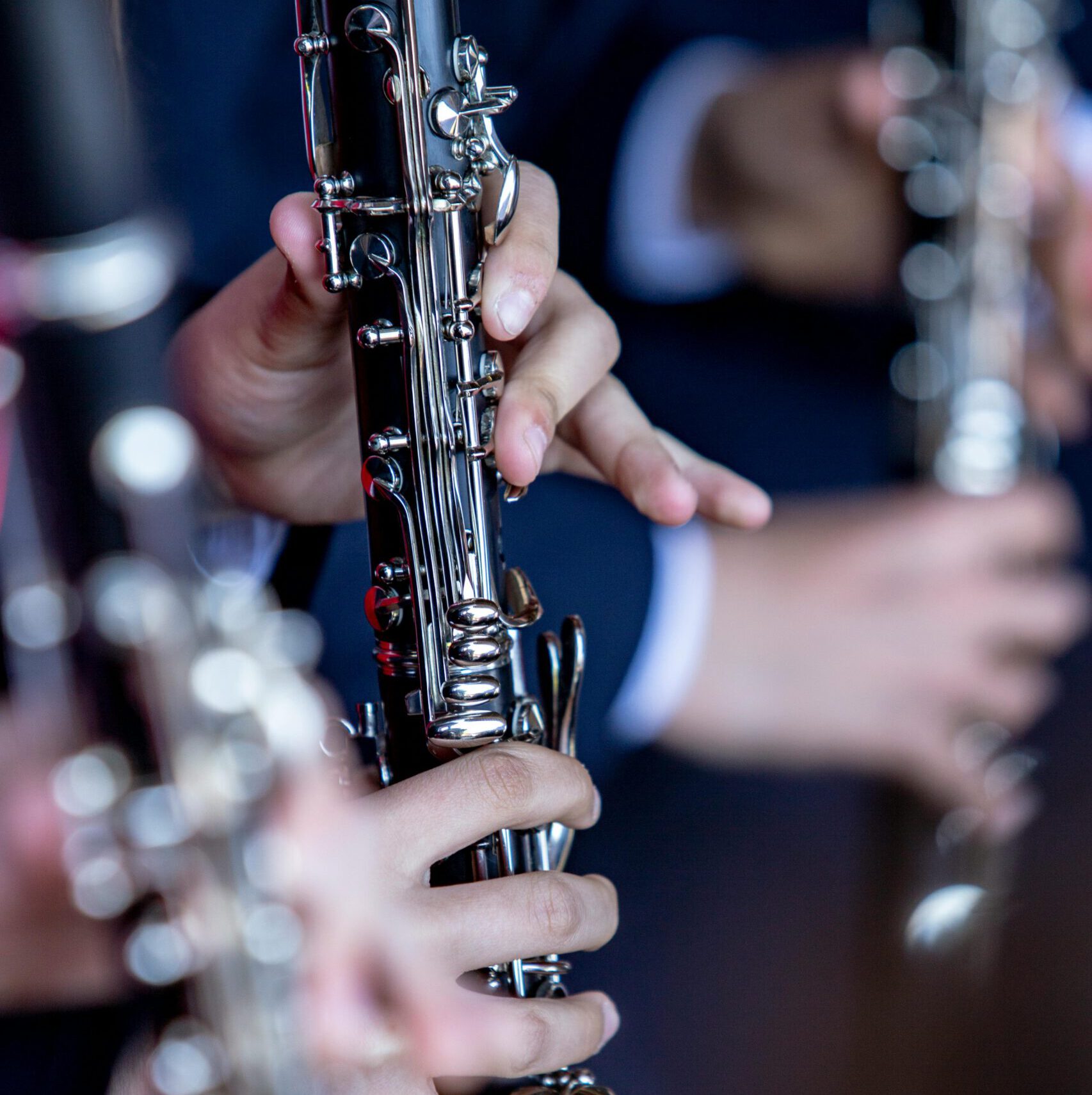The clarinet consists of a more or less cylindrical hollow tube with holes, some of which are covered by the fingers, and others with a key. The holes covered by the fingers often have a ring (called a “bril”), which operates keys that cover holes lying beyond the reach of the fingers. Additionally, the clarinet has separate keys, including those operated by the pinky finger, which open or close other holes. All the holes are located on the front side of the clarinet, except for the thumb hole, which is situated at the back. The left hand’s thumb operates both the thumb hole and a separate key called the “duodecime key,” used for higher tones.
The instrument’s end tapers into a funnel-shaped bell, which is called the “sound chamber.” This design ensures that the acoustic impedance of the tube is better matched to that of the air, resulting in increased sound production, especially in the lower tones. Clarinets are typically made from wood (especially grenadilla wood), but other materials such as metal and, more recently, plastic are also used.
The actual sound production occurs at the mouthpiece. The clarinetist places their upper teeth on the mouthpiece and holds the lower lip against the reed, which is bound or clamped to the mouthpiece using a ligature. By blowing air between the mouthpiece and the reed, the reed begins to vibrate. The lip tension (embouchure) determines how much freedom the reed has to vibrate, affecting pitch and timbre. The reed’s vibration sets the air inside the clarinet in motion, creating sound.
The hardness of the reed also plays a crucial role in the clarinet’s tone. A harder reed produces a warmer sound, but it can be more challenging for beginners to play. The reeds have a limited lifespan and need to be replaced regularly. The hardness of a reed is indicated by a number, ranging from 1 (softest) to 5 (hardest). The intermediate size, 2½, is often used by beginners.
The acoustic impedance of the tube after the reed determines the possible pitches that can be produced. A cylindrical tube closed at one end produces a harmonic series with exclusively odd harmonics. As a result, a clarinet transitions to the twelfth (duodecime) instead of the octave, unlike most other wind instruments.
A modern clarinet consists of 5 separate parts. In addition to the mouthpiece at the top and the bell at the bottom, there’s a piece called the “barrel” directly below the mouthpiece. The barrel’s inner diameter gradually increases from small to large. The middle section, which contains all the keys and holes, can also be split into two parts, making it easy to disassemble and transport the clarinet. The parts fit together airtight using cork seals.
Register for the lessons
Trial lessons
Lesson details
Age: from 7 years (younger in consultation)
Lesson duration: 20, 25 or 30 minutes weekly or once every 2 weeks, in consultation with the teacher
Lesson day(s): Wednesday, Thursday, Friday of Saturday
To buy: To be discussed
Teacher(s):
Serge Makarchev
Wednesday, Thursday, Friday of Saturday
The clarinet consists of a more or less cylindrical hollow tube with holes, some of which are covered by the fingers, and others with a key. The holes covered by the fingers often have a ring (called a “bril”), which operates keys that cover holes lying beyond the reach of the fingers. Additionally, the clarinet has separate keys, including those operated by the pinky finger, which open or close other holes. All the holes are located on the front side of the clarinet, except for the thumb hole, which is situated at the back. The left hand’s thumb operates both the thumb hole and a separate key called the “duodecime key,” used for higher tones.
The instrument’s end tapers into a funnel-shaped bell, which is called the “sound chamber.” This design ensures that the acoustic impedance of the tube is better matched to that of the air, resulting in increased sound production, especially in the lower tones. Clarinets are typically made from wood (especially grenadilla wood), but other materials such as metal and, more recently, plastic are also used.
The actual sound production occurs at the mouthpiece. The clarinetist places their upper teeth on the mouthpiece and holds the lower lip against the reed, which is bound or clamped to the mouthpiece using a ligature. By blowing air between the mouthpiece and the reed, the reed begins to vibrate. The lip tension (embouchure) determines how much freedom the reed has to vibrate, affecting pitch and timbre. The reed’s vibration sets the air inside the clarinet in motion, creating sound.
The hardness of the reed also plays a crucial role in the clarinet’s tone. A harder reed produces a warmer sound, but it can be more challenging for beginners to play. The reeds have a limited lifespan and need to be replaced regularly. The hardness of a reed is indicated by a number, ranging from 1 (softest) to 5 (hardest). The intermediate size, 2½, is often used by beginners.
The acoustic impedance of the tube after the reed determines the possible pitches that can be produced. A cylindrical tube closed at one end produces a harmonic series with exclusively odd harmonics. As a result, a clarinet transitions to the twelfth (duodecime) instead of the octave, unlike most other wind instruments.
A modern clarinet consists of 5 separate parts. In addition to the mouthpiece at the top and the bell at the bottom, there’s a piece called the “barrel” directly below the mouthpiece. The barrel’s inner diameter gradually increases from small to large. The middle section, which contains all the keys and holes, can also be split into two parts, making it easy to disassemble and transport the clarinet. The parts fit together airtight using cork seals.
Register for the lessons
Trial lessons
Lesson details
Age: from 7 years (younger in consultation)
Lesson duration: 20, 25 or 30 minutes weekly or once every 2 weeks, in consultation with the teacher
Lesson day(s): Wednesday, Thursday, Friday of Saturday
To buy: To be discussed
Teacher(s):
Serge Makarchev
Wednesday, Thursday, Friday of Saturday



